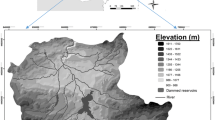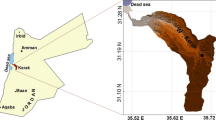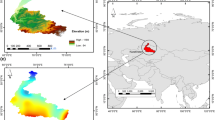Abstract
Soil erosion is a growing problem in southern Greece and particularly in the island of Crete, the biggest Greek island with great agricultural activity. Soil erosion not only decreases agricultural productivity, but also reduces the water availability. In the current study, an effort to predict potential annual soil loss has been conducted. For the prediction, the Revised Universal Soil Loss Equation (RUSLE) has been adopted in a Geographical Information System framework. The RUSLE factors were calculated (in the form of raster layers) for the nine major watersheds which cover the northern part of the Chania Prefecture. The R-factor was calculated from monthly and annual precipitation data. The K-factor was estimated using soil maps available from the Soil Geographical Data Base of Europe at a scale of 1:1,000,000. The LS-factor was calculated from a 30-m digital elevation model. The C-factor was calculated using Remote Sensing techniques. The P-factor in absence of data was set to 1. The results show that an extended part of the area is undergoing severe erosion. The mean annual soil loss is predicted up to ∼200 (t/ha year−1) for some watersheds showing extended erosion and demanding the attention of local administrators.









Similar content being viewed by others
References
Arnoldus HMJ (1980) An approximation of the rainfall factor in the Universal Soil Loss Equation. In: De Boodt M, Gabriels D (eds) Assessment of erosion. Wiley, Chichester, pp 127–132
Aronica G, Ferro V (1997) Rainfall erosivity over Calabrian region. Hydrol Sci J 42(1):35–48
Bagarello V (1994) Procedure semplificate per la stima del fattore climatico délia USLE nelPambiente molisano (Simplified procedures for estimating the climatic factor of the USLE in Molise, in Italian). Atti delta Giornata di Studio Sviluppi Recenti delle Ricerche sull’Ewsione e sul suo Controllo, Bari, 17–18 February 1994
Banasik K, Gôrski D (1994) Rainfall erosivity for South-East Poland. In: Rickson RJ (ed) Conserving soil resources. European perspectives. Lectures in soil erosion control, Silsoe College, Cranfield University, UK, pp 201–207
Benkobi L, Trlica MJ, Smith JL (1994) Evaluation of a refined surface cover subfactor for use in RUSLE. J Range Manage 47:74–78
Bergsma E (1980) Provisional rain-erosivity map of The Netherlands. In: De Boodt M, Gabriels D (eds) Assessment of erosion. Wiley, Chichester
Biesemans J, Meirvenne MV, Gabriels D (2000) Extending the RUSLE with the Monte Carlo error propagation technique to predict long-term average off-site sediment accumulation. J Soil Water Conserv 55:35–42
Bolinne A, Laurant A, Rosseau P (1980) Provisional rain-erosivity map of Belgium. In: De Boodt M, Gabriels D (eds) Assessment of erosion. Wiley, Chichester, pp 111–120
Boyle M (2002) Erosion’s contribution to greenhouse gases. Erosion Control 9:64–67
Brown LR (1984) Conserving soils. In: Brown LR (ed) State of the world. Norton, New York, pp 53–75
Chartzoulakis KS, Paranychianakis NV, Angelakis AN (2001) Water resources management in the island of Crete, Greece, with emphasis on the agricultural use. Water Policy 3:193–205
Cox C, Madramootoo C (1998) Application of Geographic Information Systems in watershed management planning in St. Lucia. Comput Electron Agric 20:229–250
Erdogan EH, Erpul G, Bayramin I (2007) Use of USLE/GIS methodology for predicting soil loss in a semiarid agricultural environment. Environ Monit Assess 131:153–161
Fernandez C, Wu JQ, McCool DK, Stockle CO (2003) Estimating water erosion and sediment yield with GIS, RUSLE,and SEDD. J Soil Water Conserv 58:128–136
Ferro V, Giordano G, Lovino M (1991) Isoerosivity and erosion risk map for Sicily. Hydrol Sci J 36(6):549–564
Ferro V, Porto P, Yu B (1999) A comparative study of rainfall erosivity estimation for Southern Italy and southeastern Australia. Hydrol Sci J Sci Hydrol 44(1):3–24
Fu G, Chen S, McCool KD (2006) Modeling the impacts of no-till practice on soil erosion and sediment yield using RUSLE, SEDD and ArcView GIS. Soil Tillage Res 85:38–49
Gabriels D, Cadron W, De Mey P (1986) Provisional rain erosivity maps of some EC countries. In: Proc. workshop on erosion assessment and modeling, Brussels, Belgium
Gong J (2001) Geography information system. Science Publishing, Beijing
Haan CT, Barfield BJ, Hayes JC (1994) Design hydrology and sedimentology for small catchments. Academic Press, San Diego, 588pp
Hussein MH (1986) Rainfall erosivity in Iraq. J Soil Water Conserv 41:336–338
Kouli M, Vallianatos F, Soupios P, Alexakis D (2007) A GIS example of morphometric analysis in two major watersheds of Western Crete, Greece. J Environ Hydrol 15(1):1–17
Krahl J, Kauffmann G, Kozur H, Richter D, Forster O, Heinritzi F (1983) Neue Daten zur Biostratigraphie und zur tektonischen Lagerung der Phyllit-Gruppe und der Trypali-Gruppe aufder Insel Kreta (Griechenland). Geol Rundsch 72:1147–1166
Lal R (1990) Soil erosion in the tropics: principles and management. McGraw-Hill, New York
Lal R (1994) Soil erosion by wind and water: problems and prospects. In: Lal R (ed) Soil erosion research methods, 2nd edn. Soil and Water Conservation Society, St. Lucie Press, America pp 1–9
Lal R (2001) Soil conservation for C sequestration. In: Stott DE, Mohtar RH, Steinhardt GC (eds) Proceedings of the 10th international soil conservation organization meeting, 24–29 May 1999, West Lafayette, pp 459–465
Lewis LA, Verstraeten G, Zhu H (2005) RUSLE applied in a GIS framework: calculating the LS factor and deriving homogeneous patches for estimating soil loss. Int J Geogr Inf Sci 19(7):809–829
Lim KJ, Sagong M, Engel BA, Tang Z, Choi J, Kim KS (2005) GIS-based sediment assessment tool Catena 64:61–80
Lo A, El-Swaify SA, Dangler EW, Shinshiro L (1985) Effectiveness of EI30 as an erosivity index in Hawaii. In: El-Swaify SA, Moldenhauer WC, Lo A (eds) So/7 erosion and conservation. Soil Conservation Society of America, Ankeny, pp 384–392
McCool DK, Brown LC, Foster GR (1987) Revised slope steepness factor for the universal soil loss equation. Trans Am Soc Agric Eng 30:1387–1396
Mikhailova EA, Bryant RB, Schwager SJ, Smith SD (1997) Predicting rainfall erosivity in Honduras. Soil Sci Soc Am J 61:273–279
Millward AA, Mersey JE (1999) Adapting the RUSLE to model soil erosion potential in a mountainous tropical watershed. Catena 38:109–129
Mitasova H, Hofierka J, Zlocha M, Iverson LR (1996) Modeling topographic potential for erosion and deposition using GIS. Int J GIS 10:629–642
Mitsios J, Pashalidis C, Panagias K (1995) Soil erosion—mitigation techniques to soil erosion. Zymel Editions, Athens
Molnar DK, Julien PY (1998) Estimation of upland erosion using GIS. Comput Geosci 24:183–192
Morgan RPC (1992) Soil erosion in the northern countries of the European Community. EIW Workshop: elaboration of a framework of a code of good agricultural practices, Brussels, 21–22 May 1992
Nyakatawa EZ, Reddy KC, Lemunyon JL (2001) Predicting soil erosion in conservation tillage cotton production systems using the revised universal soil loss equation. Soil Till Res 57:213–224
Oldeman LR, Hakkeling RTA, Sombroek WG (1991) World map of the status of human-induced soil degradation, with explanatory note (second revised edition)—ISRIC, Wageningen; UNEP, Nairobi
Onori F, De Bonis P, Grauso S (2006) Soil erosion prediction at the basin scale using the revised universal soil loss equation (RUSLE) in a catchment of Sicily (southern Italy). Environ Geol 50:1129–1140
Ouyang D, Bartholic J (1997) Predicting sediment delivery ratio in Saginaw Bay watershed. In: Proceedings of the 22nd National Association of Environmental Professionals Conference, 19–23 May 1997, Orlando, FL, pp 659–671
Renard KG, Foster GR (1983) Soil conservation: principles of erosion by water. In: Dregne HE, Willis WO (eds) Dryland agriculture. Agronomy Monograph No. 23. American Society of Agronomy, Crop Science Society of America, and Soil Science Society of America, Madison, pp 155–176
Renard KG, Freimund JR (1994) Using monthly precipitation data to estimate the R factor in the revised USLE. J Hydrol 157:287–306
Renard KG, Foster GR, Weesies GA, McCool DK (1996) Predicting soil erosion by water. A guide to conservation planning with the revised universal soil loss equation (RUSLE). Agric. Handbook 703. US Govt Print Office, Washington, DC
Renard KG, Foster GR, Weesies GA, McCool DK, Yoder DC (1997) Predicting soil erosion by water: a guide to conservation planning with the Revised Universal Soil Loss Equation (RUSLE). Agriculture Handbook No. 703, USDA-ARS
Stocking MA, Elwell HA (1973) Prediction of sub-tropical storm soil losses from field plot studies. Agric Meteorol 12:193–201
Tsagarakis KP, Dialynas GE, Angelakis AN (2004) Water resources management in Crete (Greece) including water recycling and reuse and proposed quality criteria. Agric Water Manage 66:35–47
Van der Knijff M, Jones RJA, Montanarella L (1999) Soil erosion risk in Italy. EUR19022 EN. Office for Official Publications of the European Communities, Luxembourg, 54p
Van der Knijff JM, Jones RJA, Montanarella L (2000) Soil erosion risk assessment in Europe. EUR 19044 EN. Office for Official Publications of the European Communities, Luxembourg, 34p
Van Leeuwen WJD, Sammons G (2004) Vegetation dynamics and soil erosion modeling using remotely sensed data (MODIS) and GIS. Tenth Biennial USDA Forest Service Remote Sensing Applications Conference, 5–9 April 2004, Salt Lake City, UT. US Department of Agriculture Forest Service Remote Sensing Applications Center, Salt Lake City:
Van Lynden GWJ (1995) European soil resources. Nature and environment No.71. Council of Europe, Strasbourg
Van Remortel RD, Hamilton ME, Hickey RJ (2001) Estimating the LS factor for RUSLE through iterative slope length processing of digital elevation data within ArcInfo Grid. Cartography 30(1):27–35
Wischmeier WH (1959) A rainfall erosion index for a universal soil-loss equation. Soil Sci Soc Am Proc 23:246–249
Wischmeier WH, Smith DD (1965) Predicting rainfall-erosion losses from ropland east of the Rocky Mountains. Guide for selection of practices for soil and water conservation. Agric. Handbook, 282. US Gov. Print. Office, Washington, DC
Wischmeier WH, Smith DD (1978) Predicting rainfall erosion losses—a guide to conservation planning. Agriculture Handbook No. 537. US Department of Agriculture Science and Education Administration, Washington, DC, USA, 163 pp
Wu Q, Dong D (2001) GIS based theories and methods for investigations of geological hazard and water resources. Geology Publishing Company, Beijing
Wu Q, Wang M (2007) A framework for risk assessment on soil erosion by water using an integrated and systematic approach. doi:10.1016/j.jhydrol.2007.01.022
Yitayew M, Pokrzywka SJ, Renard KG (1999) Using GIS for facilitating erosion estimation. Appl Eng Agric 15:295–301
Yoder D, Lown J (1995) The Future of RUSLE: inside the new revised universal soil loss equation. J Soil Water Conserv 50(5):484–489
Yu B, Rosewell CJ (1996a) An assessment of a daily rainfall erosivity model for New South Wales. Aust J Soil Res 34:139–152
Yu B, Rosewell CJ (1996b) Rainfall erosivity estimation using daily rainfall amounts for South Australia. Aust J Soil Res 34:721–733
Yu B, Rosewell CJ (1996c) A robust estimator of the R factor for the Universal Soil Loss Equation. Trans Am Soc Agric Eng 39(2):559–561
Acknowledgments
The project is co-funded by the European Social Fund and National Resources in the framework of the project INTERREG III B ARCHIMED, sub-project A1.020 entitled “MILDMAP—Methodology Integration of EO techniques as operative tool for Land Degradation Management and planning in Mediterranean Areas”. The authors are grateful to the anonymous reviewers for their very helpful comments and valuable suggestions.
Author information
Authors and Affiliations
Corresponding author
Rights and permissions
About this article
Cite this article
Kouli, M., Soupios, P. & Vallianatos, F. Soil erosion prediction using the Revised Universal Soil Loss Equation (RUSLE) in a GIS framework, Chania, Northwestern Crete, Greece. Environ Geol 57, 483–497 (2009). https://doi.org/10.1007/s00254-008-1318-9
Received:
Accepted:
Published:
Issue Date:
DOI: https://doi.org/10.1007/s00254-008-1318-9




